Last December, this site celebrated it’s 5th anniversary, and to celebrate, I wrote a post saying that when I first started, I never imagined the site would grow as it had. Prior to December 2014, mikeeckman.com was just an outlet for me to share my thoughts on movies, music, and other pieces of technology, with the occasional comment on politics and sports.
In the last 5 years, I’ve met a lot of terrific people along the way who have offered their help and suggestions on how to build the site, so I thought it might be a good idea to share what I’ve learned that works, and also what doesn’t. Despite all that I have learned, I still don’t know everything, so I reached out to a number of other bloggers whom you likely are already familiar with to get their thoughts and ideas for this article.
This first quote comes from one of the most successful photography bloggers out there, whose advice is much like his articles, straight to the point.
Just share what you know. Also keep the ads and crap to a minimum. I always like to keep a page clean of crud. Better quality means more readers.
-Ken Rockwell (kenrockwell.com)
Ken’s comment is right on point and an excellent way to start this article. Sharing what you know and keeping crap to a minimum is a great first step, but obviously it doesn’t stop there. There’s nothing I or any other blogger could give you that will make you an instant success, but I think this might be a good starting point for anyone crazy enough to want to get into the world of blogging.

For Love or Money
Before you write your first blog post, I think it is very important to make a decision about whether you are doing this for love or money. What I mean by that is, will your blog be something you do for fun because you have a passion for writing or some subset of photography, or are you looking to make a business out of it?
It should go without saying that creating any blog for profit is incredibly difficult. Not only will it require a ton of effort from you, but you’ll also need to enlist the help of other people as well. I can’t think of any profitable sites that are run by a single person, so you’re going to need people to help you out and it takes time to find the right people with the same goals as you.
Stephen Dowling from kosmofoto has over 25 years in online publishing and has been running his current site since 2012 and here’s his two cents:
I started Kosmo Foto (originally Zorki Photo) in 2012. I didn’t start making any money off it – I mean, actually having money in my hand after all my hosting and blog design costs had been subtracted – until last year. Seven years. That’s actually OK, because for the first few years, making money from my blog didn’t really cross my mind. It wasn’t the impetus for it. What I wanted to do was write about photography, create an outlet for stories about film cameras and analogue photography that others might find interesting.
-Stephen Dowling (Kosmo Foto)
The Internet is a fickle beast with an incredibly short attention span. Not only do you need to be able to create interesting content that people want to read, but you’ll also need to keep doing it on a consistent basis. The most successful sites publish new content regularly, which keeps readers engaged. In a typical week, I publish a review on a Tuesday and something else like a Keppler’s Vault on a Thursday, but that’s all. Two posts a week is not nearly enough to maintain a profitable site which is why you’ll need help as I cannot fathom that any single human being can put out quality content much faster than that.
James Tocchio from Casual Photophile and F Stop Cameras has a different perspective as he started both sites with the intent to run them as a business:
Casual Photophile and F Stop Cameras have been my full-time job since 2017. For three years before that, they were a second job which I engaged with at night, after the day job. My goal was always to transition from working for someone else to running my own business, so the work was always pressing and continuous. I don’t really know what it’s like to run a blog as a hobby. I imagine it would be a nice outlet for creativity or a way to improve one’s photography. I’m not sure I’d ever start a hobbyist blog, to be honest.
-James Tocchio (Casual Photophile and F Stop Cameras)
Another challenge with making a profitable blog, is in the constant demand for new content, the money it will require up front to establish the necessary technology, and finding the right staff to make that happen, you run the risk of turning what you love into work, and that often can have negative consequences. People often ask me why I don’t write a book about old cameras or shoot film photography professionally, and apart from my standard answer of “I don’t have the time”, another valid justification is that I genuinely love this site and shooting film in my free time. As soon as it becomes work, I fear I won’t enjoy it as much and I’m not willing to trade the love of what I do for the requirement of making it a business.
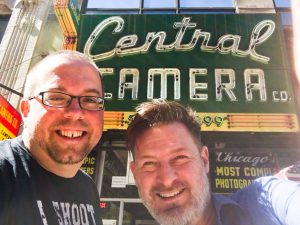
So by far, if you’re just getting started, I strongly recommend you do this for the love of it as it will not only keep you loving it, but at whatever time life gets in the way and you need to slow down or take a break, you can do it without any feeling of obligation.
Jim Grey from Down the Road sees another value for blogging, which is Community. Jim has written a number of excellent posts on why he thinks blogging is important, but this one quote about building a community is one of my favorites. Social media these days is so impersonal. Even when you do connect with someone on Facebook or Instagram, that connection can disappear just as quickly as it was formed. With a blog built around a topic you love, you will attract other like-minded people and build a community that is long lasting and far more satisfying than the number of “Likes” you have on Facebook.
Community. That’s the point and purpose of blogging today. We might search for and never find that kind of community locally; few people around us might share our interests. But the Internet opens us to a much larger portion of the world. With a little effort, even the most esoteric interest can find community online.
-Jim Grey (Down the Road)
Think Before You Jump
Once you have come to terms with why you want to start a photography blog, doing a little planning to prepare for what kind of blog you want will help you reach your goals faster. A random blog with no goals and no direction is not appealing to anyone. Not only that, starting off with a clear direction will help eliminate possibly having to start over later on. With the right planning and the right intentions you can have a successful site sooner than later.

For starters, you need to decide what kind of site you want to create. Depending on this answer, the path to success will look a little different.
- Do you want to focus on actual photography or gear? If so, what kinds?
- If photography like Johnny Martyr or Alex Luyckx, are you looking to showcase your own photography or that of others?
- Will the nature of your photography be artistic or technical? Are you more Andy Warhol, Ansel Adams, Vivian Maier, or Arthur “Weegee” Fellig?
- Do you want to showcase film, digital, or both?
- If you’re looking for a gear oriented site, are you going to review the gear yourself, or just write about what others are using?
- Will your site be about vintage cameras like mine, or are you more interested in new stuff like Ken Rockwell?
- Are you planning on writing original content like kosmofoto, 35mmc, or EMULSIVE?
- Do you want to include photography news about the latest Kickstarter like Petapixel?
- If you’re looking to run your site like a business, are you going to have a store selling used cameras like fstopcameras, or film like kosmofoto?
For me, I started out writing reviews of old cameras, but eventually started including historical magazine articles in my Keppler’s Vault series and some original content like the Rotoloni Report, and One Hour Photo series, and well, this article. For the most part though, a large focus of anything I write is historical in nature as that’s what fascinates me the most.
Perhaps you aren’t yet ready to commit to a specific “sub-genre” and want your site to be more all purpose, and that’s OK too. Just know that there are a LOT of all purpose photography sites out there and until you really start to develop your own niche, it is going to be more difficult to stand out from those other sites.
I think that anyone who’s starting from the ground floor should take a bit and assess what the end goal is. If you’re starting a blog to make money, you need to understand how you’re going to do that and then try to ensure that every decision you make from day one is geared toward reaching your target audience, target revenue, etc. If you’re starting a blog as a hobby, try to determine beforehand why you’re doing it. To share your images with family? To improve your photography over time? To eventually become a pro photographer, or network toward that end? Determining your desired end point will help you make every decision along the way, and get you to that endpoint faster and easier.
-James Tocchio (Casual Photophile and F Stop Cameras)

If you’re looking to do a camera review site like mine, I’ll let you in on a little secret. For as much as I love researching and writing about obscure cameras like the Aires Radar Eye, or the Ikko Sha Start 35 K-II, these cameras are obscure for a reason, which is that not many people are interested in them. I take a certain amount of pride in that I might have one of the only in depth reviews of the Pouva Start on the entire Internet, but those articles simply do not attract anywhere near the traffic of a review for the Pentax K1000 or Leica M3.
Another great tip is people love lists or articles which are the Top 5 or 10 (type of camera) for the (subset of photography) here. My recent Eleven Unfortunately Named Cameras article has out performed any single post I’ve written this year, even though I used stock photos for almost every camera in that article and have never shot a single one of them.
Now, I’m not recommending you go out and start a new blog with only reviews of the Pentax K1000 and top 10 lists, but incorporating more things that people are more likely to want to read, is a great way to build up your traffic quicker.
Best Tip Ever
This next tip is so important, that I think it deserves it’s own section, which is.
Have a thick skin.
-Mike Eckman (Some random site)
It shouldn’t be a surprise to anyone that on the Internet, people have opinions, sometimes strong ones, and if you deviate even slightly from the preconceived notions that some people have, they’re going to let you hear about it. It might come in the form of a gentle correction, to an all out flaming email about how much you suck, your site sucks, your writing sucks, and pretty much how your own life sucks.
With success comes more attention and with more attention comes more criticism. So far, I’ve been pretty fortunate to not have to deal with too many trolls, but there have been a few people who have criticized my grammar and frequent misuse of the words it’s and its, and others who have accused me of writing fiction.
One of my favorite emails was this one where a user wrote me this long essay explaining the proper use of “its” with an without an apostrophe. I responded to the reader thanking him for his email and letting him know that I actually do know the difference, but its just a common (did you see what I just did there) typo that I make, which WordPress’s built in spell checker does not always catch.
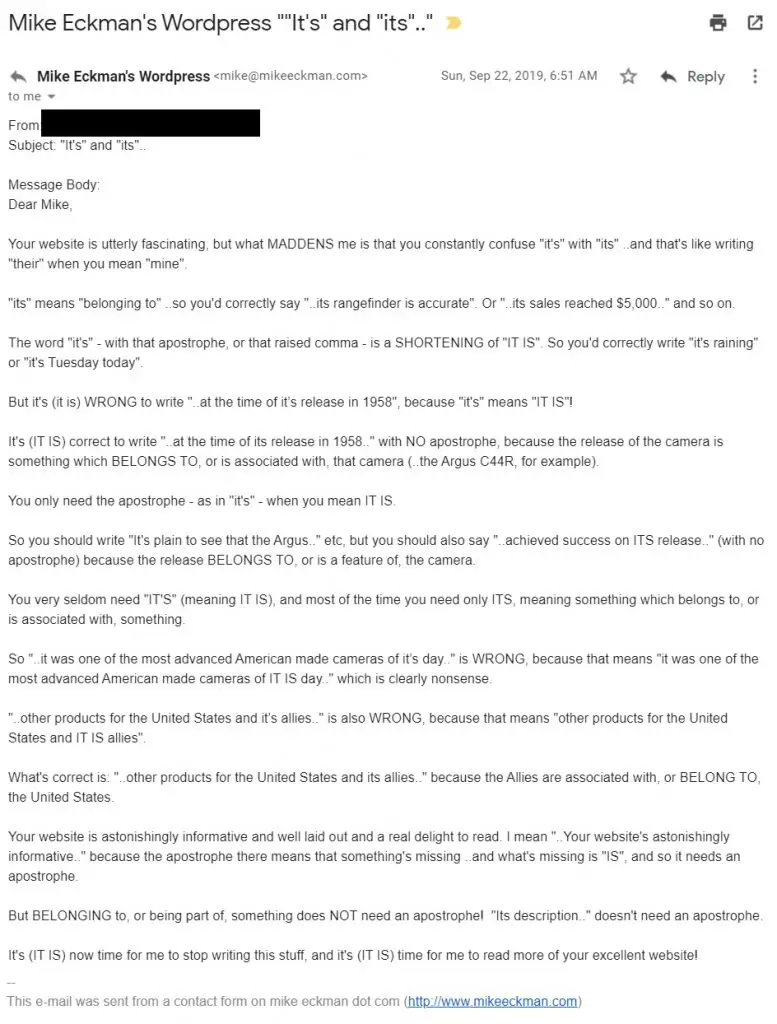 In another interaction on Facebook with a completely different reader, I was criticized so heavily that the reader swore never to read my site again because it bothered him so much. I wish I had archived that conversation but I didn’t.
In another interaction on Facebook with a completely different reader, I was criticized so heavily that the reader swore never to read my site again because it bothered him so much. I wish I had archived that conversation but I didn’t.
The point is, you’re going to get some people who just don’t like what you do, and that’s OK. It is going to happen and the best thing you can do is to not let it bother you. In some cases, the criticism might actually be valid, just presented in a poorly worded manner, and in those cases, maybe you can benefit from the intent of what the person is unable to convey in a constructive and helpful manner, but in other instances, it’s just best to ignore them. Don’t ever take it personally, and as the sign says, “Don’t feed the trolls.” You’re better than that.
Almost everyone who puts anything up online will at some point or another experience negativity from some faceless entity on the other side of an Internet connection. My site’s audience tends to be well-read individuals who seem to possess above average capacity for thought, which is great, and this more thoughtful readership is something that we actively cultivate by producing the type of articles that we produce. It helps to keep the comments section clean and instructive and useful. That said, there have been a fair number of useless, aggressive and negative comments over the years.
-James Tocchio (Casual Photophile and F Stop Cameras)
Choose Your Platform
This one’s going to be pretty short as I only have experience with one platform, WordPress. Since the overwhelming majority of other bloggers I know also use it, it’s probably a good idea to give it serious consideration.
In this post from March 2019, it was stated that 313,050 of the top 1 million websites use WordPress. I can only imagine that that number has increased in the last 14 months since it was written, but even if it hasn’t, using a platform that one-third of the most popular Internet site use puts you in good company.
WordPress is certainly not your only option as there are compelling reasons to consider Wix, Squarespace, and even Blogger, but with whatever advantages those might offer over WordPress, knowing so many people who are on the same platform as you means you’ll have an easier time asking for help and getting answers to your questions or problems, than if you used a less popular platform.
Stephen Dowling from kosmofoto.com is one of the most experienced bloggers I know, with over 25 years of experience and he doesn’t hesitate to recommend WordPress:
Go with WordPress as it’s the easiest publishing platform I’ve encountered, and in 25 years on online journalism that’s a few. WordPress makes it easy, and at first, it needs to be easy.
-Stephen Dowling (Kosmo Foto)
Assuming you’ve decided to use WordPress, how you host it is a bit more complicated of a question as there are quite a few options out there that range in price from free to hundreds of dollars a month.
As is the case with nearly everything, there is no one single “best” option that universally works for everyone. Free WordPress hosting is great for the first time blogger who only wants to casually write posts and doesn’t really see themselves expanding.
If you want to just get started with WordPress, head on over to their Free Hosting site and get started. Little to no technical knowledge is required to create your first blog, and you can have it up and running in less than 5 minutes. WordPress’s free hosting gives you enough tools to get started, but as you might imagine, there’s a lot of things it doesn’t do, so if you think there’s a chance that you might one day want to take your site seriously, you might want to consider starting off with a paid hosting account.
Blogger Jim Grey from Down the Road is a big fan of the WordPress Personal plan saying that the free plan is littered with ads and is too limiting. I’ve personally never used both, so I would definitely take his recommendation seriously.
Today the free tier of WordPress.com is littered with crap ads. It’s a shame. But if you’re skint this is a way to start. I recommend people buy their Personal plan to start, which is $48/year. It removes the ads and lets you choose your own domain (i.e., you go from blogname.wordpress.com to blogname.com), for an annual domain registration fee that varies with your domain name.
-Jim Grey (Down the Road)
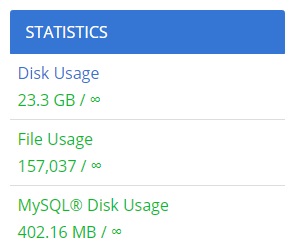
Since January 2019, mikeeckman.com has been hosted by Bluehost on a shared server. The difference between a shared and dedicated server means that the resources needed to power this site are used by other sites as well. This has a negative impact in speed and responsiveness, but is also much cheaper. I chose a 5 year hosting contract with an average monthly cost of $5.50 per month.
Despite the slower performance of my current server over a dedicated server, the site is still much faster than my previous hosting solution and it includes unlimited storage which is important for a photography site that has a lot of large images. Nearly every photo on this site, whether it’s a picture of the camera being reviewed or a scan of a sample image I shot with it, is between 1-3 megabytes each. Currently, the site uses 23.3 gigabytes of storage over 157,037 files, which on a host that required me to pay for storage would get quite expensive.
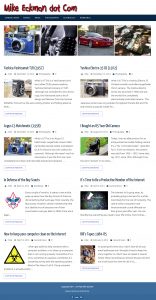
Choosing a host and a plan could be an entire post in itself, so I won’t go too much more into this decision as this is something that I strongly recommend you do some research yourself and ask around. I am happy with Bluehost and can happily recommend them, but there are certainly other great hosts like Hostgator and Siteground that may work just as well for you. Whichever you choose, just make sure that they specialize in WordPress as it will make things much easier.
Your Branding
Whether you want your site to be a full fledged business or a hobby site that you create for fun, you should still seriously consider your branding. I don’t think there are many people who would want to go through the effort of creating a site and writing content for it, if they knew no one would read it. Before you write your first post, you should consider branding, which starts with it’s name.
This is one area which I wish I could do differently had I know where this site would go when I first started. Although mikeeckman.com is a fine name for a site, it doesn’t exactly call out “Vintage Camera Reviews, Stories, and Articles”. Sites like Japan Camera Hunter, Casual Photophile, and Aly’s Vintage Camera Alley give you a pretty good idea of what to expect simply by looking at their name.
When branding a blog, it’s important to think about what you are branding. Are you branding you? Are you trying to be the expert in a particular field? In which case maybe the blog should include your name. Or maybe you want it to be a resource on a particular subject? 35mmc was named as such as I wanted a short snappy name that in some way related to the topic of 35mm Compact cameras. Of course, over time it’s grown to now cover more than just that topic, but because of that strong branding in the early days, a lot of people think of the site as a site about 35mm Compact cameras.
-Hamish Gill (35mmc)
I first registered the domain name mikeeckman.com in 2011 and back then I didn’t even have a website. I used it as an FTP site and to host an obscure music streaming service called Firefly. I didn’t even discover WordPress until late 2012 and over the course of the next two years, I only used it for occasional ramblings about movies, music, and other things. Even when I wrote my first camera review in December 2014, I would still occasionally write non-camera articles about my favorite albums of the year and some other things.
I didn’t fully commit to the site in it’s current form until late 2016, and by then I had already been using mikeeckman.com and I didn’t want to change the name unless I really found a name I loved. I considered a variety of options that I thought would work, but none that I loved enough to want to start over with. Even if I had, as the site grows, changing your name not only changes your brand, but it also causes a host of technical problems such as broken links, losing search engine rankings, and the likelihood of 403 “Page Not Found” errors. These can be overcome with some behind the scenes work with redirects, but that required more work than I wanted to put into it, just to change the name.
Alex Luyckx from alexluyckx.com and the Classic Camera Revival Podcast is in a similar situation as I in which his brand is his own name and here is what he had to say on the subject:
While a catchy name is important, consistency in content is probably more important than anything else. Keeping content on a brand that you have developed will help even the most boring sounding name catch on. While I run with my own name, Alex Luyckx, it is a unique name that helped me get my content ‘out there’ but I have also built a blog based on photography and used that to leverage both film/camera/lens/developer reviews along with the Classic Camera Revival Podcast. Building a brand is beyond a name, it’s content that will make your name known.
-Alex Luyckx (alexluyckx.com)
So mikeeckman.com stuck, and now after 5+ years, most people associate my name with camera reviews, much like Ken Rockwell’s name is associated with photography. Creating a brand with your name can be done, it just takes longer, so unless you are really committed, it’s worthwhile to think of your branding before you commit too much.
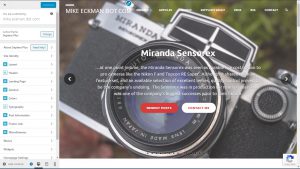
Your Design and Style
Once you have some goals for your site, know what you want to write about, have selected your platform and what you want to call it, you need to develop a design for your site and a style for your writing. These are probably the hardest things to do right away because both evolve over time as people learn what works and what doesn’t.
One of WordPress’s greatest strengths is also one of it’s weaknesses, which is how flexible it can be. There are tens, maybe even hundreds of thousands of themes and plugins that you can use to change how your site looks and functions and when you first get started, it can be overwhelming. You’re going to want to try out various options and experiment with how you want things to work.
It is understandable to switch between different themes multiple times at the beginning, but ideally you want to eventually select something and stick with it. That’s not to say you can’t still change things later on, but you want to avoid having whole site redesigns often as it can alienate your readers. Think of it like a grocery store. Once you get familiar with where everything is in your local store, if they keep moving things around and putting them in different aisles, you’re quickly going to get frustrated each time you go buy more groceries, and if there was a competing grocery store nearby that didn’t change as often, you might consider shopping there instead.

A common mistake that I see new bloggers make (and some experienced ones) is making a site that’s too cluttered. WordPress has a ton of neat plugins that display a boat load of relevant info to what you want to write about but if you include too much other stuff, it can distract from your main content.
In terms of your text, it might be fun to go crazy with fonts, but using widely supported fonts is better, as is using text that’s easy to read. That means no yellow text on a colored background. And speaking of backgrounds, don’t ever use an image in your background. If you want something a little easier on the eyes than pure white, go with some shade of gray with black text. Nothing screams an amateurish website with images in the background and egregious use of fonts and colors.
Your site’s design is only part your style though, and I could go on and on about recommended website style tips, but there’s already a ton of great articles out there that go over the do’s and don’ts of web design, but just as important as the web design is your writing style and organization.
When it comes to organizing your content, think ahead, make a plan and adapt sooner rather than later if you feel you might need to. I’m currently 7 years in and going through the process of re-organizing, re-categorizing and re-tagging 1450+ articles. It’s taking weeks, and I wouldn’t wish this on anyone. The sooner you can get your navigational structure in place, the better
-Hamish Gill (35mmc)
One of the most heavily debated aspects of my site is how long my posts are. A typical camera review here is between 4000 and 5000 words, with some exceeding 8000. My Argus C-Series article came in at over 12,000 words so I decided to publish it as 5 separate posts devoted to different sections of the same article.

For many, an 8000 word article about a single camera is far too long, and they’re not wrong. While writing this article (which itself is almost 8000 words) I searched a variety of other sites for what they consider to be the ideal length of a blog post and the numbers ranged from as low as 1600 words to as high as 2400 words. If we just extrapolate that 2000 is a nice number of words to be, you can see that my average articles are anywhere from two to four times too long.
This definitely has a negative effect on my readership as an overwhelming number of people simply don’t have the time, patience, or desire to read such long posts, but that is a decision I have conscientiously made. I make every effort I can to include as much relevant info about a camera as I can.
 When you read a review about a camera on mikeeckman.com, I want it to be an all encompassing and thorough article that covers as much information I can possibly find on it. I do my best to not completely plagiarize similar content found on other sites, but I will borrow bits and pieces here and there.
When you read a review about a camera on mikeeckman.com, I want it to be an all encompassing and thorough article that covers as much information I can possibly find on it. I do my best to not completely plagiarize similar content found on other sites, but I will borrow bits and pieces here and there.
Sometimes I’ll get stuck on something and need to consult with some other expert, or use a variety of resources to get the information I need and that can take months.
The average amount of time for me to write a review from start to finish is about 2 months. If I start writing a review on May 8th, it’ll most likely be done in early to mid July. But some take quite a bit longer. Look at the revision history on the right of a recent post that I started in December 2019, but did not finish until April 7th.
I am not suggesting you start writing excessively long posts, but I do suggest you write appropriate posts for your target audience. My site will never have the traffic as Petapixel because I do not cater to quick and easy news stories. I have never had a post trend on Twitter or Instagram. My audience is generally people researching the history of a particular camera they have, or want to buy. My site is a “one stop shop” for historical information, specifications, how to instructions, sample results, a little bit of opinion, and a whole lot of reference material.
That is my style and it works for me, but it’s definitely not for everyone. Before you can have a successful site, you need to determine what will work for you. What is your writing style, how much time are you willing to put into each post, what do you want your readers to get out of your posts?
SEO
 There are a lot of things about making a successful blog that you can worry about later, but one that is worth learning about early on is something called Search Engine Optimization, or SEO for short.
There are a lot of things about making a successful blog that you can worry about later, but one that is worth learning about early on is something called Search Engine Optimization, or SEO for short.
In a nutshell, SEO is a set of guidelines or best practices that your site should follow which make it easier for your readers to find your content on search engines. Nearly 75% of my site traffic comes from search engines. This is actually a high number as I should try and get more traffic from social media like Facebook and Instagram, but that’s actually harder to do. Good traffic from search engines is better for long term success than a trending topic on Twitter or Reddit.
Of that 75% of traffic that comes from search engines, over 90% of my traffic comes from Google, so basically, it is in my best interest to do whatever Google demands to make sure my site is easily found, or “ranks” in Google search results.
If you are new to blogging, this likely is going to be pretty confusing (heck, I barely understand it now), but don’t worry as you can learn about it later, but it is important to establish good SEO as early as possible, because if you don’t, you’ll find yourself wanting to fix it later, and that will require a ton more work.
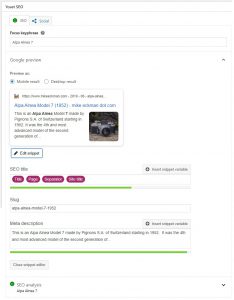 For the beginner, I recommend two steps. The first is to sign up for Google Analytics. It’s absolutely free and all you need is a Google account and a website to sign up. You don’t even need to know how to use Google Analytics as the sheer amount of information there is overwhelming, but the advantage of signing up for their service as soon as you start your site, is it allows Google to build a profile for your site which you can use later to learn more about your traffic.
For the beginner, I recommend two steps. The first is to sign up for Google Analytics. It’s absolutely free and all you need is a Google account and a website to sign up. You don’t even need to know how to use Google Analytics as the sheer amount of information there is overwhelming, but the advantage of signing up for their service as soon as you start your site, is it allows Google to build a profile for your site which you can use later to learn more about your traffic.
Even if you never check your Google Analytics site for the first couple of years, once you do, you’ll have a couple years worth of data to sift though. If you wait to sign up until you need it, you wont have a long history to look at.
The second is to install a WordPress plugin called Yoast SEO. Yoast is a popular and free plugin that inserts additional code into your posts behind the scenes that make your content more easily found by search engines like Google.
It sounds complicated, but Yoast does most of the work for you. The only thing you need to do is spend a minute to fill out a short form for each new post you write. This involves giving it a keyphrase, a slug, and a description that search engines can use to more easily display your content in their search results. Yoast will also give you a a quick analysis of your post with any recommendations it has for optimizing your site.
I’d encourage new bloggers to keep it simple: automate as much technical SEO as possible with plugins like Yoast or RankMath and make sure they add titles and excerpts to each post. As far as the on-page SEO goes, for bloggers who want to rank, writing good content should be the #1 priority: that means writing well, as well as writing things people want to read and have value. Be clear, concise, make an actual point and if you ask questions, answer them. SEO is important but it’s only a small part of the wider picture. If you get into good habits at the beginning, a huge part of your SEO efforts will become just another part of your editorial workflow and you can move onto the more complex and time-consuming stuff.
-EM (EMULSIVE)
With good SEO, you make your site and your content more easily found by search engines and for sites like me where I get nearly three quarters of my traffic from them, it’s a big deal.
My review for the Alpa Alnea Model 7 is the number one search result on Google when searching for “alpa alnea model 7”. This wouldn’t have happened had Google not been able to find and index that post correctly.
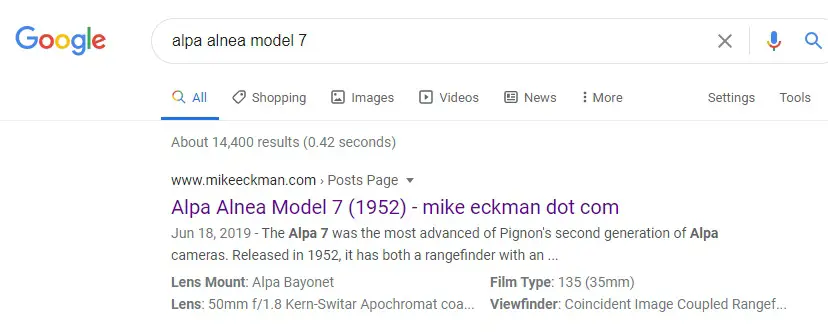
There is a lot more to learn about SEO and analytics, but you can figure that out later. By getting started with Google Analytics and following good SEO practices as soon as you start your site, you’ll set yourself up for greater success later.
WordPress Plugins
Assuming you’ve chosen WordPress as your platform, one of the first things you’ll likely discover is the overwhelming number of plugins you can install on your site. The free WordPress tiers have a limited support for plugins, but most paid plans do an excellent job of simplifying installation and removal of plugins. Most plugins are junk and completely not necessary, but there are a few that you should know about.
For the beginning blogger, here are five that I recommend to everyone.
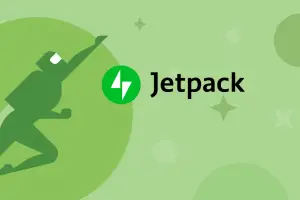 Jetpack by WordPress.com – Jetpack is probably the most essential of all WordPress plugins and comes pre-installed on a variety of hosting options. I honestly think that Jetpack’s features are so important, that I don’t understand why they’re not just built into WordPress to begin with. Like most WordPress plugins, there is a free version and several paid options that offer more advanced features. Since this article is aimed at the beginner, I’ll only talk about the free version which offers features such as:
Jetpack by WordPress.com – Jetpack is probably the most essential of all WordPress plugins and comes pre-installed on a variety of hosting options. I honestly think that Jetpack’s features are so important, that I don’t understand why they’re not just built into WordPress to begin with. Like most WordPress plugins, there is a free version and several paid options that offer more advanced features. Since this article is aimed at the beginner, I’ll only talk about the free version which offers features such as:
- Site Stats – See how your site is performing on a daily, weekly, monthly, or annual level.
- Post Sharing – Easily share your posts to Facebook, Twitter, or other social media sites.
- Additional Security from Brute-Force Attacks, spam protection, and enhanced login features.
- Easier Plug-In Updates – One of the most common WordPress attacks is vulnerable plug-ins and Jetpack makes updates simple.
- Enhanced Photo Galleries – Since you’re making a photography site, you probably want to display your images and Jetpack gives you more options.
- Site Subscriptions – A good way to keep people coming back to your site is to offer email subscriptions
- Improved Image Hosting – Jetpack offers ways to host your images that are not only more secure, but will improve site performance.
The paid Jetpack plans also offer excellent site backup options which I strongly recommend. Other features include improved support for SEO, eCommerce (selling things on your site), and advertising that you may want to consider later on as your site grows, but probably not at the beginning.
 Akismet Anti-Spam – Akismet is actually part of Jetpack that can be installed as a standalone plugin for people who want it but not Jetpack. I recommend both as they work together, but Akismet is what you’ll need to keep spam bots from ruining your Comments sections of your posts (assuming you have them turned on). As WordPress continues to grow in popularity, more and more sites are the target for comment spam. You would be surprised at how quickly you can start to see garbage comments on your posts and Akismet does an excellent job of filtering more than 99.9% of those out. Check out the stats to the right which say that nearly 100,000 spam comments have already been blocked.
Akismet Anti-Spam – Akismet is actually part of Jetpack that can be installed as a standalone plugin for people who want it but not Jetpack. I recommend both as they work together, but Akismet is what you’ll need to keep spam bots from ruining your Comments sections of your posts (assuming you have them turned on). As WordPress continues to grow in popularity, more and more sites are the target for comment spam. You would be surprised at how quickly you can start to see garbage comments on your posts and Akismet does an excellent job of filtering more than 99.9% of those out. Check out the stats to the right which say that nearly 100,000 spam comments have already been blocked.
Wordfence Security – With Jetpack and Akismet, you have dramatically increased your site’s ability to protect itself, but only with a program like Wordfence Security will you have complete protection from hackers out there who might want to take your site down. Wordfence is a web based firewall that actively monitors your site and protects it from attacks. In the unlikely event your site is attacked, Wordfence has paid experts which can help you regain control of your site.
A feature of Wordfence that I like is their regular email updates that alert you to known attacks and vulnerabilities, alerting you to security settings you might want to check on your site, or plugins that you might have installed which have been compromised. Last year, I had a PDF plugin that I was using that had become compromised, and Wordfence quickly alerted me to the threat and recommended I remove it. I’ve since moved onto a different plugin that I am happy with.
There are paid Wordfence plans, but for me, the free option is what I use as I think my site isn’t big enough to need the more advanced options. And of course there are other web firewall programs besides Wordfence, so if you decide not to use it, I highly recommend something similar.

Yoast SEO – In the previous section, I already explained how important SEO is, and the best way to leverage it is with a plugin like Yoast. Since I’ve already talked about it, I’ll just move on after taking one more opportunity to mention it.
WP Statistics – Earlier I recommended signing up for Google Analytics, and while Google’s site gives you a dizzying array of information, it’s not something a new blogger will likely want to immerse themselves with. Until you have a need or desire to look at tons of stats, the WP Statistics plugin is perfect for the beginner that gives several really easy to understand charts and bar graphs showing how your site is performing. There are other, much more advanced statistics plugins that do more than WP Statistics, but they aren’t all free and aren’t targeted towards beginners.
I use WP Statistics in addition to other, more advanced plugins like Monster Insights as I like their interface, and I don’t always need a hundred different ways to see how my site is performing.
Establish Relationships with Other Bloggers and Experts
This site is still largely a one man operation. I created it, I do all the behind the scenes IT work for it, I shoot my own cameras, develop and scan the film, I research write and edit the posts, and I publish the posts. In the few occasions where I’ve included original or republished work from someone else, I credit them, but I can say that 99% of what you read here was written by me.
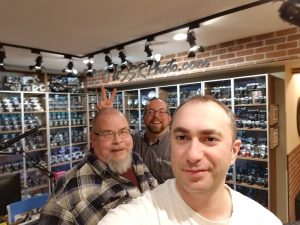
That said, I’d be lying if I said the site is what it is without the help of others. What many readers may not know is that I constantly collaborate with other bloggers. I reach out to experts like Robert Rotoloni, Wes Loder, Vladislav Kern, Richard Oleson, Chris Sherlock, Paul Sokk, Larry Gubas, and many, many others for help in researching each article. I have submitted content that has been published on other sites and solicited material from other bloggers (such as this post). Back in 2017, I started a private chat with a variety of other bloggers whom I respect and we collaborate on an almost daily basis, asking each other questions about articles we’re writing about.
Sometimes we talk about gear, sometimes we talk about developing, sometimes it’s technical in nature to solve a problem with WordPress. My decision to switch to Bluehost and start running ads here came out of feedback I received from other bloggers. I also believe in “take a penny, give a penny” and I’ve helped other newer bloggers get some exposure, answer questions, and offer encouragement in their own website endeavors.
One of the newest bloggers that I collaborate with is Alyssa from Aly’s Vintage Camera Alley, and she says she has benefited greatly from networking with other bloggers:
When I first started I had virtually no visitors to my blog. I’m still experiencing growing pains but my traffic has increased since I started networking with other bloggers. A lot of my traffic comes from people sharing my page on their website. I’ve learned you can’t just write a blog and hope people find it. You have to share it on social media and find fellow bloggers who will be nice enough to share your articles as well.
-Alyssa Chiarello (Aly’s Vintage Camera Alley)
Even though many of these bloggers write classic camera reviews like I do, and sometimes our material crosses paths, I don’t see them as competition, rather I see them as inspiration. In a recent update to his review for the Zenit-E, Stephen Dowling included links to other reviews such as mine, and that of Alex Lyckx, which in turn, inspired Alex to update his own post.
Whether you write books, paint, take photos, or write camera reviews, talk to other people who do the same things as you, and ask questions. You don’t have to necessarily do what they say or copy their work, but by seeing what has worked or not worked for them, can help you on your own journey.
Back in 2018, I added a feature to this site that includes RSS feeds from the websites of these other bloggers that automatically shows the five most recent posts from each site with a very short summary and a link to that post. In the navigation bar for mikeeckman.com near the top of your screen is a link for RSS Feeds, which contains five links each to 15 of these sites. Many of them you likely already know and possibly even visit, but if you’re in the mood to read more about photography and vintage cameras, it’s a great one stop shop for more reading material.
This so called Camera Bloggers Alliance has helped me more ways than I can count, and I feel as though the site has greatly benefited from the relationships I’ve built with these other men and women. Maybe a private chat isn’t for you, but I definitely encourage you to reach out to other people who do something similar to you and try to talk to them and ask questions. You’d be surprised at how much help you can get if you ask nicely.

Keep At It
Creating a successful blog is just as much about how much effort you continue to put into it as it takes to get it started. You’ll have to promote yourself by participating in social media discussion groups that pertain to your particular subset of interest. Create dedicated Facebook or Instagram accounts for your page. I’ve done it with both of those, but am still trying to figure out how to best leverage them in a way that doesn’t require a ton of effort on my part.
Interact with your readers, whether it’s through social media or through the comments on your own site. Make sure you respond to comments and questions sent to you from your readers. Even a simple thank you on a comment goes a long way as people like to know they were heard.
Most blogs fail because of infrequent posting. It doesn’t become part of their weekly schedule. Life gets in the way, and blogging can be like gym routines – harder to keep to unless you’re disciplined. It’s much easier to write a post when you’ve already written 20 in the last month. You’re in the zone. And here’s another tip from someone who’s had a blog for eight years, and been a working journalist for 30: story ideas breed other story ideas. They’re frisky and enjoy bumping against each other.
-Stephen Dowling (Kosmo Foto)
The most important piece of advice I can give is to keep at it, don’t give up, and be patient. Whether you’re making a blog for love or money, it is likely going to take you a long time to build up readership. As I write this, this site averages just shy of 1.2k views per day and it’s taken me over 5 years to get there.
My first camera review was published in December 2014, and in the first 12 months after that, I was averaging 48 views per day. I did not reach 500 views per day until August 2017 and 1000 until January 2019. I am happy with those numbers because I do this for fun, but if I wanted to be famous or make a living out of this, I’m clearly on the wrong track.
(Writing a successful blog is difficult because) there’s so much noise out there that unless you’re active in the community, no-one’s ever going to see it. You need to ask yourself, “what value does this have to people other than me?” If you can’t come up with a compelling answer but enjoy doing what you’re doing, don’t stop. If you’re struggling with growing the website, then you have the beginning of a plan: what can you do to make your content more compelling and ultimately more useful?
-EM (EMULSIVE)
Another thing to consider is how to possibly supplement your site. Alex Luyckx supplements his site with the Classic Camera Revival Podcast on Podbean, and Hamish Gil from 35mmc and EM from EMULSIVE both have the Hypersensitive Photographer’s Podcast on Soundcloud.
Aly’s Vintage Camera Alley has a supplemental YouTube channel which she uses to record video demonstrations for cameras that she writes about on her blog, which increases visibility for those who require a more visual style.
Additional Reading
Hopefully you’ve found some helpful tips in this article and maybe even some inspiration. Starting a blog, establishing your brand, and using the right plugins and SEO practices is only the beginning. There’s more you’ll want to learn about and do in the months and years to follow.
There are also a great number of other articles and forums online that can help you along your way.
In this article, I’ve quoted several other bloggers whom I respect, but one of them, Jim Grey has written about why you should start a blog and the things needed to make it successful a number of times. Here are some of his posts that I recommend you check out when you have the time.

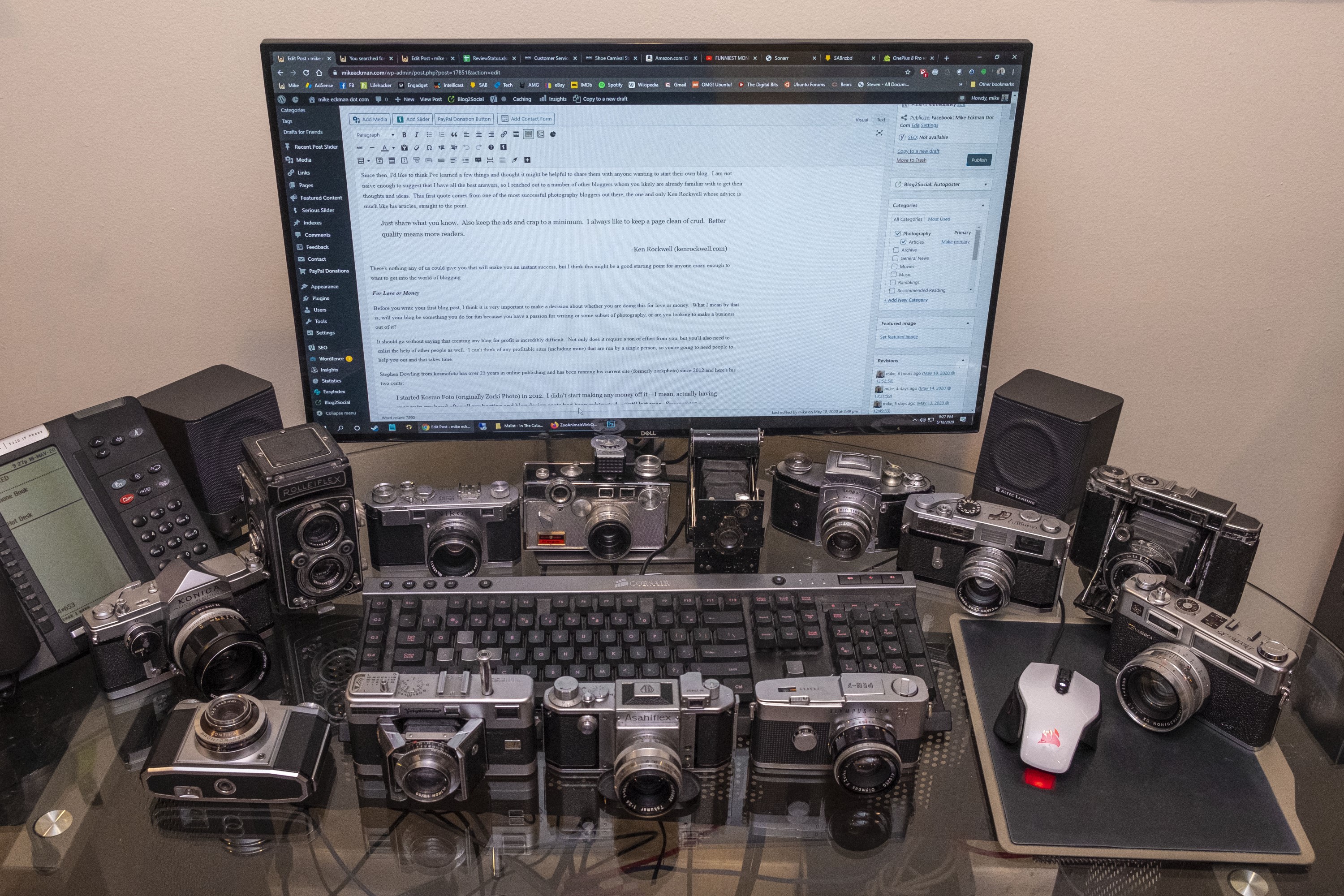

Mike, After reading this, I’m not proposing going into competition with you any day soon.
I never cease to be amazed at the amount of information one can find on the net. It is for this very reason that a site needs to stand out from a myriad others competing for my attention. I doubt it really matters that your name doesn’t explicitely say it is photography related, leave this to the search engine. But what is very important fom a reader perspective is authority, content and syle. I am far more interested in the eras of the cameras that you review and this is what, for me, makes the site the premier one for collectible and vintage cameras. A number of the cameras that you’ve reviewed I either have owned, or still do, so it is very interesting seeing another’s perspective on them.
Those of your reviews of the more obscure cameras either cover models I’ve read about, or had no knowledge of. Indeed from one review I was even tempted to buy one, and I did.
The strength of a site like 35mmc draws in a different readership as it facilitates easy access for readers who would like to submit short articles about their experiences with specific camera/film combinations, and usually the cameras are from the more readily available and usable and which will likely be of far more interest to those thinking of taking up film photography.
Reader comment/feedback is important, and moderation should seriously be given to keeping out the trolls. No reader likes seeing nasty comments in an otherwise excellent site.
Keep up the good work.
What Hamish Gill said about organising is very important. I’m 15 years into blogging and I’ve got quite a bit of crud.
Always great to hear from other bloggers, Khurt! I just checked out your site and see you have both camera and beer reviews! What a great idea!!!
Mike: With pros like you, and Hamish, the krew at 35MMC, and at The Film Photography Project already blogging, there’s no need for us dweebs to jump in!
Thanks as always Roger! I am always happy to share what I know, and it’s great to have those other ideas to bounce ideas and ask for help with to make my site better. While I’m happy to know that your needs are being met, I’ll never stop encouraging new bloggers!
Thanks Mike this is good reading and full of good advice that I wish I had had sooner (particularly about SEO). I am one of those bloggers who hasn’t achieved the expectation he had when he started and it is mainly (I think) that I didn’t have a clear vision at the start and my blog has wondered from general things to camera reviews and currently in a sort of spin as I decide what the hell I am doing. There was a point when I was blogging regularly that I had a reasonable readership but to prove your point above; I dropped back and now readership is low.
Thanks again, you site is one of THE site for camera information and recently even for purchasing inspiration and I respect all that you do.
Nigel, thanks as always for the kind feedback. I don’t recall ever visiting your site, would you be able to send me a link to it? Even though I say in this article to start your site with a plan of where you want to go with it, starting off with no expectations has it’s benefits too as you are happy with whatever you get! I do this myself and it’s always good to hear that kind of feedback from you guys and it makes me feel good also to know that I am the cause of other people’s spending habits! 🙂
Sorry Mike, I did reply to this but for some reason it didn’t seem to get through (also the reply button on your site seems not to work for me),
Anyway, you are most welcome and as requested you can find my blog either via http://www.carrotroom.com or directly at https://carrotroom.wordpress.com/
It is true that not having a fixed idea allowed me to be flexible and adapt the blog as things moved along.
I am writing a short post about that purchase which I may put on 35mmc or my blog, not sure which yet.
There is a lot of good advice in here. I have a few friends starting blogs at the moment. I will forward this post to them. Though the name/brand one might be too late. For myself I am happy with my site name, though I do wish it wasn’t almost the same as a porn site 🙂 that is something to be aware of as well.
Haha! You know Peggy, porn is still very popular and there is a lot of demand for it, so maybe you can make lemonade from lemons and see if there’s a way you can capitalize on that traffic for your site! 🙂